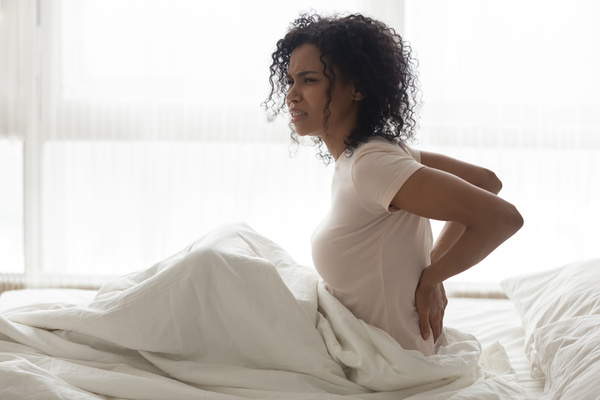
When you’re in pain, it can be hard to get enough sleep. When you’re running on low sleep, everything hurts more. When pain and sleep interfere with each other, it can become a vicious cycle that is difficult to break.
In this guide to the intersection of pain and sleep, we cover what you can do to improve your sleep if you suffer from chronic pain.
How Do Pain and Sleep Interact?
According to the National Sleep Foundation, the majority of Americans who suffer from chronic pain also report substandard sleep, and 1 in 4 of those chronic pain sufferers also have a sleep disorder. Pain can make it more difficult to fall asleep, or to get deep, restorative rest. At the same time, impaired sleep quality can worsen pain throughout the body.
The good news is that the reverse is also true: good sleep can help alleviate pain. There are many things you can do to make your sleep easier when you have chronic pain. Here are a few.
Sleeping Positions and Chronic Pain
Your sleeping position has a major impact on how you feel throughout the day. When you sleep, your muscles are held in a position that might not be natural and may make you feel worse because they’re being used incorrectly as you sleep. The most important thing to remember is that your body needs to be aligned correctly: your ear, shoulder, and hip should form a straight line. You may also find yourself needing additional support from extra pillows or other soft supports.
Sleeping On Your Back
Sleeping on your back is the best sleeping position for alleviating pain since back sleepers keep their spine in neutral alignment without their body weight pressing on the spine or causing tension. To make this position more therapeutic, you can sleep with your knees elevated by placing a pillow or two under your legs. This allows your spine to assume its natural curvature. I can also help to place a small rolled towel under your neck.
Sleeping On Your Side
If you prefer to sleep on your side rather than your back, you can achieve a neutral spine alignment by placing a pillow under your neck and another between your knees. This helps to facilitate a healthy spinal alignment and alleviates back pain.
Furthermore, side sleepers should avoid sleeping with their knees bent toward their face in the fetal position, as this promotes an uneven distribution of weight that may cause sore joints and pain. You should also avoid any sleep position where you’re twisting your body or hip. This ‘sidewinder’ position, which derives from a side sleeping position, can cause back and hip pain.
Sleeping On Your Stomach
Stomach sleeping is the worst option for those dealing with chronic pain since it puts a lot of pressure on the spine and surrounding muscles. Stomach sleeping flattens the spine's natural curve and puts extra pressure on the lower curve of the spine. This is even more exaggerated in people with a high degree of lumbar lordosis, which is often associated with lower back pain. Sleeping on your stomach also forces you to turn your neck, which can cause pain in the neck, shoulders, and upper back.
Stomach sleepers should place a small pillow under their stomach which helps keep the back slightly arched, thus mitigating lower back pain. However, if you can teach yourself to sleep on your side or back instead, you will ultimately be much more comfortable. It can be challenging to re-teach yourself how to sleep in a new position, but you can do it by propping yourself in position with pillows.
Lifestyle Tips for Pain-Free Sleep
In addition to changing up your sleeping position, there are a few lifestyle changes you can make to improve sleep and reduce pain before bed. Some of these are small changes to introduce to your daily routine, while others are more impactful events, like rethinking your mattress and pillow arrangements.
Match Your Bed to Your Body
What we sleep on has a huge impact on how well we sleep. Make sure you have a supportive mattress and pillows. If you have chronic back pain, you may need a firmer or softer mattress than you’re used to. Heavier people tend to need firmer mattresses and lighter people tend to need softer ones to get the proper support and alignment when lying down.
Your sleeping position can also have a major impact on what mattress is most suitable for your body. Back and stomach sleepers will typically do better on firmer mattresses, while side sleepers will sleep better on softer mattresses that can cushion their impact points and provide better contouring.
Practice Good Sleep Hygiene
If some nights are more restful than others, your sleep hygiene may play a role. Having good sleep hygiene means having both a bedroom environment and daily routines that promote consistent, uninterrupted sleep. Keep your bedroom dark and cool, and avoid screen time at least an hour before bed to let your body’s natural cues kick in. Have a consistent bedtime. Avoid large meals, caffeine, and alcohol before bedtime. Getting physical exercise during the day can also help you fall asleep more readily at night.
Practicing a relaxation technique or meditating before going to bed can also reduce pain and improve sleep.
By having good sleep habits, you can set yourself up for success.
Stretch Before Bed
Stretching or yoga before bed can be extremely beneficial for chronic pain relief. A great deal of chronic pain can be linked to muscle misuse; when muscles are taught habits that stress or strain the muscles and we continue to use them in those habit patterns, it results in pain. Stretching these muscles out with gentle yoga poses or other stretching exercises before bed can help retrain them for a less painful morning. See this article for some suggested poses: 8 of the Best Yoga Poses for Sleep
Maintain Good Posture
Another change you can make to ensure better sleep is to maintain good posture throughout the day. Good postural alignment can help with chronic pain overall because good posture trains the muscles to work properly and helps. The Upright Go posture trainer can help you learn to stand and sit straighter.
Teas and Supplements for Better Sleep
Herbal Tea
If you’re struggling with insomnia, a simple herbal tea could help to give you some relief. Ingredients like Lemon Balm, Valerian Root, and Chamomile can help to relax the mind and body, and ease you into a comfortable, uninterrupted sleep. Each of these herbs can also be taken as a supplement or tincture to help induce sleep and may be used on their own or in combination depending on what works for you.
Melatonin
If you’re averse to taking pharmaceutical medications after years of unsuccessful attempts you may be hesitant to take melatonin, but melatonin is an entirely natural supplement that can be highly effective for treating insomnia. Melatonin is a hormone produced by the pineal gland, so it’s already naturally present in our bodies. This important hormone helps us to keep a regular sleep-wake cycle but isn’t always available in sufficient amounts to put us to sleep and keep us asleep. Exposure to blue light before bedtime from electronic devices prevents natural melatonin production.
Taking a melatonin supplement is a quick, easy, and often highly effective way to make yourself feel sleepy and can help you to wake up less throughout the night. The smallest dose is .3 mg. Start small and work your way up. The most effective dose is one that promotes sleep without leaving you hung over the next day.
Magnesium
Adding more magnesium to your diet or taking a magnesium supplement may also help you achieve more restful sleep. It is also a muscle relaxant that can reduce muscle pain. Magnesium is available in a variety of foods including leafy greens, tofu, milk, and whole grains, however, many people do not get enough magnesium from their diet and magnesium deficiency is common. Magnesium supplements are widely available and magnesium lotions and bath salts are also available for absorption through the skin. There are many different forms of magnesium with many beneficial effects. Some are more effective for promoting muscle relaxation and sleep than others. Here is a chart of the different types of magnesium and their primary effects:

CBD
CBD is derived from marijuana or hemp. CBD interacts with the body’s endocannabinoid system, which regulates pain and the sleep/wake cycle, among other functions. It is being widely used by many in the U.S. to treat pain, anxiety and insomnia. According to the American Sleep Foundation, there is now research to back up its helpful effects for promoting better sleep. It is mostly commonly taken as an oil under the tongue or in gummies.
Kratom
Kratom has recently become a hot topic for its potential to treat individuals struggling with chronic pain, anxiety, insomnia, opioid addiction and withdrawal, but kratom is far from a modern fad. Used for centuries in Southeast Asia to treat pain and a variety of other conditions, this powerful plant has deep roots in natural wellness. Today, Kratom continues to be a popular herbal supplement, used by more than 15 million Americans to treat pain associated with a variety of conditions.
Kratom supplements are made from dried, powdered kratom leaves, and are available in three distinct types: white, green, and red kratom. These “strains” or varieties of kratom are determined by the color of the veins that run through the leaves of the kratom plant. Sometimes these veins are red, sometimes green, sometimes white, depending on the age of the plant. Younger plants have white veins, more mature plants have green veins, and full grown plants have red veins.
Each variety of kratom has its own benefits:
- White: gives users an energy boost
- Green: induces positive mood
- Red: is mildly sedative and helps relax the body
For people that want to improve sleep and reduce pain, red kratom is the best choice. White kratom can help get you going if you are struggling to get moving after a poor night’s sleep, but take it earlier in the day.
A Device That Helps Pain and Sleep:
Auragen Light & Sound System
The AuragenTM Light & Sound System is a light-therapy and brain entrainment device that can be used to enhance physical wellness and improve sleep, among a variety of other benefits. The device has a several light and sound frequency settings to provide a full range of therapies for a variety of conditions and ailments. By combining different modes and customizing Auragen’s settings, users can easily create a personalized treatment program for their particular needs.
To address pain, the AuragenTM Light & Sound System combines powerful blue-turquoise and red light with secondary near-infrared light in the RELIEF setting to trigger photobiomodulation, which fuels the production of adenosine triphosphate (ATP cellular energy) to accelerate healing. The resulting anti-inflammatory effects and improved circulation further promote healing and reduce pain.
To help improve sleep, try the CALM setting, which combines blue-turquoise and near-infrared light with secondary red light. Blue-turquoise light is known to help reset circadian rhythms, reduce sleep disturbances, and improve overall sleep quality. Add theta flicker for enhanced relaxation.
There's More
There are even more strategies and therapies that can help, including essential oils, massage (including self-massage), acupuncture, dietary changes and more. The bottom line is that if your pain is interfering with your sleep, there is a lot you can do to make it better.
Find an Alternative Pain Treatment Provider Who Can Help
See All of Our Recommended Pain Relief Products
 Sonja Henrikssen is a content writer who specializes in culture, cannabis, plant medicines, wellness and marketing. She is a graduate of Loyola University Chicago and continues to reside in the Chicago area.
Sonja Henrikssen is a content writer who specializes in culture, cannabis, plant medicines, wellness and marketing. She is a graduate of Loyola University Chicago and continues to reside in the Chicago area.











Comments